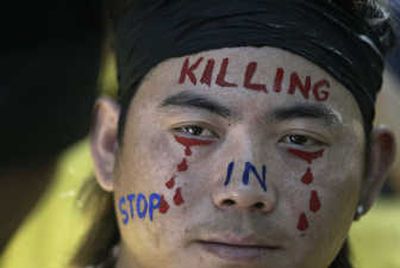Protests spread from Tibet

TONGREN, China – Protests spread from Tibet into three neighboring provinces Sunday as Tibetans defied a Chinese government crackdown, while the Dalai Lama decried what he called the “cultural genocide” taking place in his homeland.
Demonstrations widened to Tibetan communities in Sichuan, Qinghai and Gansu provinces, forcing authorities to mobilize security forces across a broad expanse of western China.
In Tongren, riot police sent to prevent protests set off tensions when they took up positions outside a monastery. Dozens of monks, defying a directive not to gather in groups, marched to a hill where they set off fireworks and burned incense in what one monk said was a protest, according to a reporter at the scene.
In a sign authorities were preparing for trouble, foreign journalists were ordered out of the Tibetan parts of Gansu and Qinghai provinces.
Meanwhile, police in the Tibetan capital, Lhasa, searched buildings as a Monday deadline loomed for people who took part in a violent anti-Chinese uprising last week to surrender or face severe punishment.
Speaking from India, the Dalai Lama, the spiritual leader of Tibetans, called for an international investigation into China’s crackdown on demonstrators in Lhasa, which his exiled government claims left 80 people dead. China’s state media has said 10 civilians were killed.
“Whether intentionally or unintentionally, some kind of cultural genocide is taking place,” the Dalai Lama said, referring to an influx of Chinese migration into Tibetan areas and restrictions on Buddhist practices.
Tensions also boiled over outside the county seat of Aba in Sichuan province when armed police tried to stop Tibetan monks from protesting, according to a witness. The witness said a policeman had been killed, and three or four police vans had been set on fire. Eight bodies were brought to a nearby monastery while others reported that up to 30 protesters had been shot, according to activist groups the Tibetan Center for Human Rights and Democracy and the London-based Free Tibet Campaign.
Sunday’s demonstrations followed nearly a week of protests in Lhasa that escalated into violence Friday, with Tibetans attacking Chinese and torching their shops, in the longest and fiercest challenge to Chinese rule in nearly two decades.
The Chinese government attempted to control what the public saw and heard about protests that erupted Friday. Access to YouTube.com, usually readily available in China, was blocked after videos appeared on the site Saturday showing foreign news reports about the Lhasa demonstrations, montages of photos, and scenes from Tibet-related protests abroad.
Television news reports by CNN and the BBC were periodically cut during the day, and the screens went black during a live speech by the Dalai Lama.
Thubten Samphel, a spokesman for the Dalai Lama’s government, said multiple people inside Tibet had counted at least 80 corpses since the violence broke out Friday. The figures could not be independently verified because China restricts foreign media access to Tibet.
In Lhasa, hundreds of armed police and soldiers patrolled the streets on Sunday. Hong Kong Cable TV reported some 200 military vehicles, carrying 40 to 60 armed soldiers each, drove into the city center.